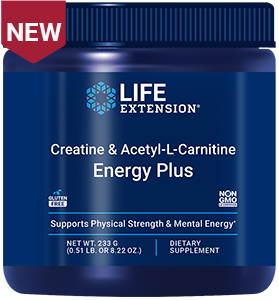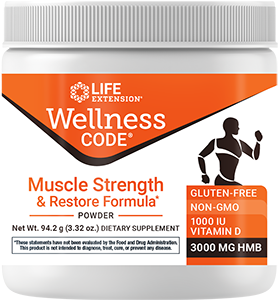
14 Best Workout Routines for People Over 50
Published: October 2024
Everything from your hobbies to your hair color changes as you get older. So, it should come as no surprise that your workout routine needs to evolve, too.
Your body at 50 simply moves differently than it did at 25—and that's okay! No one's telling you to quit running marathons or to stay off the black diamonds and do Pilates for the rest of your life. You can do anything you set your mind to.
That said, there are some specific strength training exercises and fitness routines every adult over 50 years of age should be doing to support muscle strength, balance, mental health and overall well-being.
Ready to stop wasting precious time and energy on the wrong workout? Then, let's cut right to the chase.
What are the best exercises for adults 50+?
There are three main areas of fitness that are most important for older adults: strength training, balance and cardiorespiratory health. That means the best exercises for adults over 50 are the ones that focus on these three areas.
While other aspects of fitness—like speed, agility, quickness and flexibility—need to be addressed, they come later. Strength training, balance and cardiorespiratory health are the foundation.
Use the specific exercises and workout routines listed below to develop these areas. Once you've established a good foundation, you can integrate the other training components into your active lifestyle.
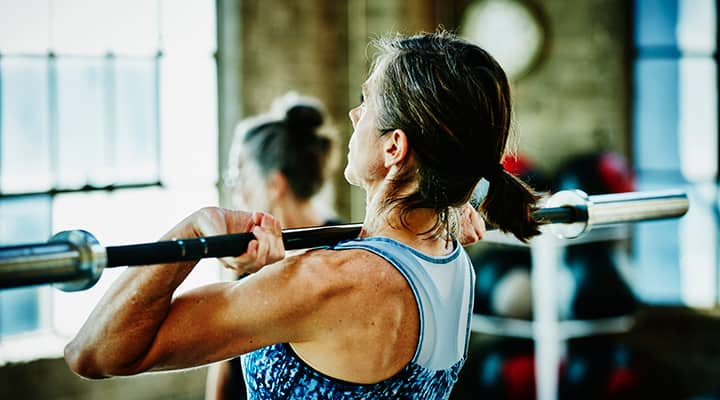
Strength training exercises
Strength training is important, because it builds lean muscle mass and helps maintain bone density, both of which naturally decline with age. This makes it more important than ever to maintain your mighty muscles.
If that's not motivation enough, lean muscle mass is highly effective at burning calories. So, when you build muscle, you increase your metabolism and make it much easier to manage weight.
Pro tip: Take a creatine supplement before, after or during your resistance training routine to support lean muscle and a better body composition.
How Do I Get Started with Strength Training?
Many people find lifting weights to be at least a little intimidating. When you first walk into a gym and see a sea of machines, you're overwhelmed and have no idea where to start. The solution is to choose exercises that align with the six basic human movement patterns:
- Squat
- Hip hinge
- Push
- Pull
- Press
- Rotate
These movement patterns help strengthen all major muscle groups and move you through all planes of motion. Whether you're new to fitness or a seasoned athlete, everyone should be working through these basic movement patterns to support activities of daily life (ADLs).
Think about getting in your car. You have to step to the side (sagittal plane) and bend your knees to sit down (squat) into the seat. You probably do this every day, multiple times per day. But if you trained your body to do it well, something as simple as getting in and out of your car could be effortless.
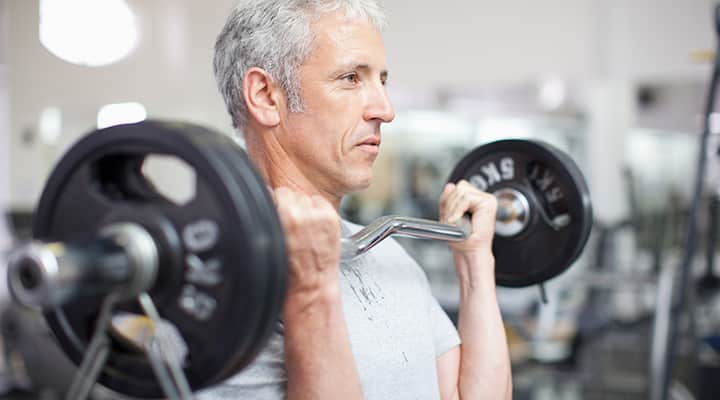
Of course, there are a million different variations, but the following exercises incorporate basic human movement patterns and provide the most bang for your buck.
-
Barbell back squat (squat)
—The back squat recruits multiple muscle groups and multiple joints at one time, making it an all-around excellent choice for increasing full-body strength.
-
Lateral step-up (squat)
—The step-up is proven to be one of the best exercises for glutes because it activates those muscles more than any other movement.
-
Romanian deadlift (hip hinge)
—This strengthens your back, hamstrings and glutes, so you can maintain good posture all day long.
-
Seated lat pulldown (pull)
—Lat pulldowns work the large muscles in your upper back that you use to pull open doors or lift heavy objects.
-
Bird dog low row (pull)
—This exercise requires core stability while you're pulling, which mimics everyday tasks like pulling laundry out of the dryer or vacuuming the floors.
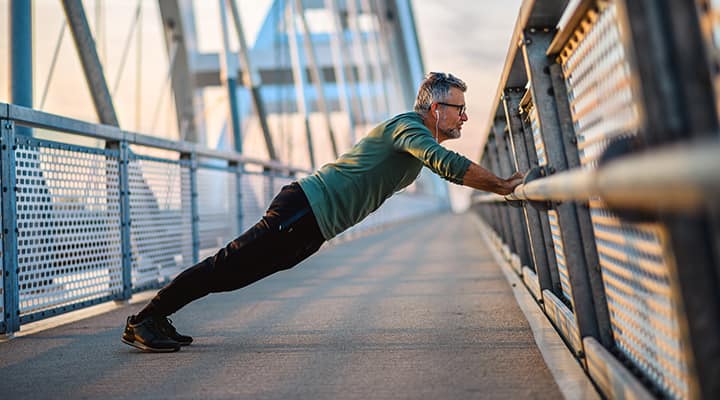
-
Push-up (push)
—Push-ups work the same upper-body muscles as a bench press with dumbbells or a barbell (pectoralis, triceps, deltoids). The difference is, you have to maintain a plank position in a push-up, which also engages the abdominals and low back muscles.
-
Arnold press (press)
—This variation on a seated dumbbell press that focuses on the shoulders is named after the man who made it popular: Arnold Schwarzenegger. He liked it so much because the rotational movement works all three heads of the deltoids to improve shoulder flexibility.
-
Reverse lunge with rotation (rotational)
—Reverse lunges are one of the gentlest exercises you can do to strengthen your knees. When you add a torso rotation at the bottom of the lunge, you add another plane of motion. Working through multiple planes of motion at one time is what your body does naturally every day, so this is an excellent exercise to train for ADLs.
Explore Our Best Active Lifestyle & Fitness Supplements
-
Dead bug (anti-rotational)
—This core-strengthening exercise involves raising and lowering opposite arms and legs while engaging your core. Known as an anti-rotational movement, this kind of exercise teaches you to stabilize through your trunk and core while moving your limbs. This directly translates to runners and power walkers, who need a steady core while they move. Training anti-rotational exercises also helps improve your ability to perform rotational movements, like swinging a golf club.
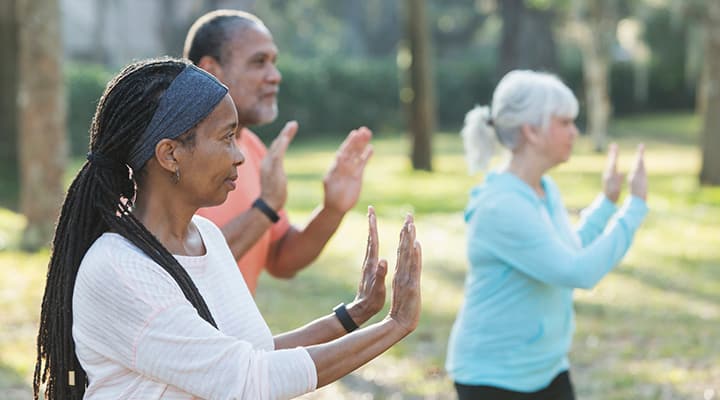
-
Balance exercises
—Balance can also decline with age. If you simply don't have the strength to maintain posture and stability, you can easily lose your balance. The good news is you can improve your balance with the right type of workout.
-
Tai chi
—Tai chi is a low-impact exercise that involves flowing through slow, controlled poses that are synced with your breath. It's similar to yoga, except you're standing on your feet and moving the whole time. For this reason, tai chi is highly effective at improving proprioception (your awareness of your body in space) and an essential for maintaining balance. Most research on tai chi involved practicing at least once per week for 12 weeks. With a weekly cadence, you should feel the difference in your physical and mental health.
-
Cardiorespiratory health exercises
—Cardiorespiratory health refers to the functional capacity of your heart and lungs. Just like a muscle, you need to work the heart and lungs in order to help them build strength and endurance. You can do this through aerobic activity, also known as "cardio." With a regular cardio routine, you can support not just your heart and lungs, but your brain health, mood and overall quality of life.
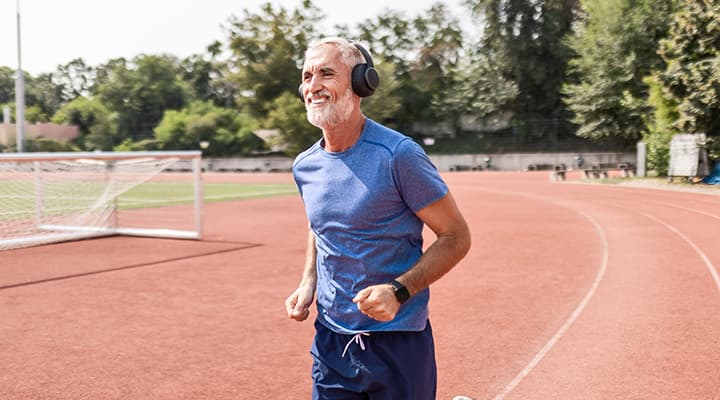
-
Moderate-intensity aerobic exercise
—The American Heart Association defines moderate-intensity to be anything that increases your heart rate and makes you breathe harder, while still being able to hold a conversation. Some examples of moderate-intensity aerobic activity include brisk walking (2.5 miles per hour), ballroom dancing, riding a bike slower than 10 miles per hour or taking a water aerobics class. You need to do at least 150 minutes per week of moderate-intensity physical activity. If you're new to exercise, ease into it with low-impact cozy cardio that you can do from the comfort of home.
-
High-intensity interval training (HIIT)
—A HIIT workout involves brief periods of intense aerobic activity, followed by a short rest. While this requires lots of energy, you get a high return on your investment. HIIT workouts can increase muscle mass, lower body fat, help you maintain already healthy blood pressure and even boost brain function. The best part about HIIT is you can alternate between work and rest periods as many times as you like. Your workout could be as short as four minutes or as long as 40. And, you don't need many sessions. Stick to one or two HIIT workouts per week.
What amino acids are needed for building muscle after 50?

The process of muscle building is dependent on protein synthesis (the production of protein). As the building blocks of protein, amino acids are required for this process.
However, muscles won't grow and get stronger unless your body is synthesizing more protein than it breaks down. Prioritizing high-quality protein at every meal and snack is one way to give your body the amino acids it needs. But food alone may not be enough, which is why amino acid supplements come in handy.
More specifically, you're looking for branched-chain amino acids (BCAAs), including essential amino acids leucine, isoleucine and valine—which your body cannot produce on its own. BCAAs are well-studied for supporting the body's ability to build muscle—and not just in the young and fit. BCAAs have been shown to stimulate muscle protein synthesis and increase muscle strength in older adults as well.
What other supplements could support your fitness goals?

Don't let all your hard work at the gym go to waste. When you have a solid workout program, you need an equally effective nutrition plan to help muscles recover, repair and rebuild. You already know you need to supplement with BCAAs, but what else can you add to your daily routine to hit your goals?
Protein
—You cannot build strong quads or beefy bicep muscles without adequate protein in your diet. The Recommended Dietary Allowance (RDA) for protein is 0.8 – 1.0 grams per kilogram of body weight per day. However, active individuals need closer to 1.6 – 2.0 grams per kilogram of body weight per day.You can meet these goals by consuming meat, seafood, dairy products, nuts, seeds and legumes. If your diet is lacking those foods, or you need a more convenient option, protein supplements are aplenty. Whey protein isolate is the most bioavailable form, meaning your body can readily use the protein.
Creatine
—Creatine is an amino acid derivative that plays an integral role in cellular energy production. Those who take a creatine supplement regularly notice positive changes in their exercise performance and body composition. That said, creatine is, perhaps, most important for maintaining lean muscles.
HMB with vitamin D
—Even though beta-hydroxy beta-methylbutyrate (HMB) sounds like a science experiment, it's actually a naturally occurring compound in your body. If you're over 50, HMB should definitely be on your radar.Several randomized controlled trials have confirmed that HMB supplementation can "aid in increasing muscle strength in the elderly population." Even if you don't regularly engage in weight training, HMB with vitamin D3 can enhance muscle strength and functionality.
Glutamine
—Generally speaking, the average healthy adult makes enough of this conditionally essential amino acid on their own. However, you may still consider supplementing with glutamine for two reasons: glutamine supplementation has been shown to support muscle recovery and it's an important amino acid for immune cells and gut health.Pro tip: Looking for more ideas? Take our supplement quiz to get matched up with exactly the right nutrients for your age, gender and fitness goals. Getting fitter after 50 is not nearly as hard as you think, especially if you're choosing the right exercises for your body, fueling properly and staying consistent with your routine.
References
- Antonio J, et al. "Common questions and misconceptions about creatine supplementation: what does the scientific evidence really show?" J Int Soc Sports Nutr. February 2021. https://pubmed.ncbi.nlm.nih.gov/33557850/
- Coqueiro AY, et al. "Glutamine as an Anti-Fatigue Amino Acid in Sports Nutrition." Nutrients. April 2019. https://www.ncbi.nlm.nih.gov/pmc/articles/PMC6520936/
- Lin Z, et al. "Effect of β-hydroxy-β-methylbutyrate (HMB) on the Muscle Strength in the Elderly Population: A Meta-Analysis." Front Nutr. July 2022. https://www.ncbi.nlm.nih.gov/pmc/articles/PMC9326439/
- O'Bryan SJ, et al. "Progressive Resistance Training for Concomitant Increases in Muscle Strength and Bone Mineral Density in Older Adults: A Systematic Review and Meta-Analysis." Sports Med. August 2022. https://pubmed.ncbi.nlm.nih.gov/35608815/
- Park S, et al. "Higher Branched-Chain Amino Acid Intake Is Associated with Handgrip Strength among Korean Older Adults." Nutrients. May 2021. https://www.ncbi.nlm.nih.gov/pmc/articles/PMC8146867/
- Rathmacher JA, et al. "Long-term Effects of Calcium β-Hydroxy-β-Methylbutyrate and Vitamin D3 Supplementation on Muscular Function in Older Adults With and Without Resistance Training: A Randomized, Double-blind, Controlled Study." J Gerontol A Biol Sci Med Sci. November 2020. https://www.ncbi.nlm.nih.gov/pmc/articles/PMC7566440/
- "American Heart Association Recommendations for Physical Activity in Adults and Kids." American Heart Association. January 2024. https://www.heart.org/en/healthy-living/fitness/fitness-basics/aha-recs-for-physical-activity-in-adults
- "The health benefits of tai-chi." Harvard Health Publishing. May 2022. https://www.health.harvard.edu/staying-healthy/the-health-benefits-of-tai-chi
- "Report: Adults 50 and Older Need More Physical Activity." Centers for Disease Control and Prevention. April 2024. https://www.cdc.gov/physical-activity/php/reports/adults-50-and-older.html
Always be in the know!
Access the latest deals, wellness news, expert health tips & more!

